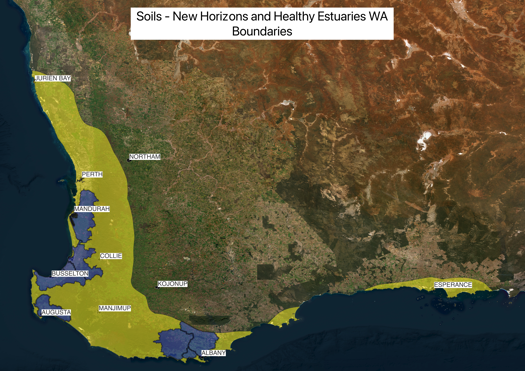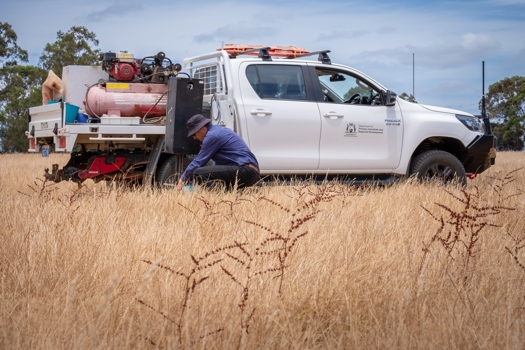Whole farm nutrient mapping
Whole farm nutrient mapping (WFNM) helps graziers make informed evidence-based nutrient management decisions. By using soil test results, nutrient use can be optimised to increase profitability and reduce nutrient run-off to nearby waterways.
WFNM programs
The WFNM process provides a science-backed approach to pasture fertiliser management, supporting graziers to maximise pasture productivity by applying only the nutrients required to address key limitations. Through evidence-based fertiliser management graziers can enhance soil health, productivity and environmental sustainability.
Soils – New Horizons is a WFNM program run by DPIRD. This program expands the activity to all graziers within the greater than 550 mm rainfall zone (outside of current Healthy Estuaries WA catchments).
The program is a bilateral partnership agreement between the Australian Government and the State Government of WA through DPIRD and a key component of the National Soil Action Plan (2023-28).
DPIRD is continuing to deliver WFNM as the Fertiliser Management program in partnership with the Department of Water and Environmental Regulation. This activity is a part of the WA State Government programs: Healthy Estuaries WA and the Bindjareb Djilba Protection Plan. More information on the Fertiliser Management program.

Program participants receive:
- training in and use of specially developed soil sampling equipment
- subsidised soil sampling
- delivery of colour coded maps and tables at an interactive workshop providing decision support tools, interpretation and agronomic advice
- follow-up subsidised agronomic advice and support
- $4000-$5000 estimated value for $300-$375 (for a 15-paddock farm).
Eligibility
To be eligible to participate in the program, farms need:
- >550 mm long term annual rainfall
- to be pasture based (paddocks in annual or perennial horticulture or in crop are not eligible)
- an arable area greater than 40 ha used for pasture.
Expressions of interest
Expressions of interest for the 2025/26 sampling programs are currently closed for both WFNM programs.
You can still submit an EOI, however it will be considered in the following sampling season (2026/2027).
Targeting fertiliser applications to align with pasture growth is an important puzzle piece for profitability within grazing systems. By analysing and interpreting representative soil test results, nutrient use can be optimised to target pasture production. This balances profitability, productivity and sustainability by improving nutrient use efficiency and reducing nutrient loss into nearby waterways while maintaining or improving production.
The WFNM process involves:
- collecting representative soil samples from each paddock based on a standardised sampling methodology.
- testing soil samples for phosphorus buffering index (PBI), phosphorus, potassium, sulfur and pH.
- comparing results against validated nationally agreed critical soil test values.
- creating colour-coded nutrient maps and tables to guide fertiliser application
- using the nutrient and lime calculator tools and agronomic advice to develop fertiliser action plans.
- ensuring accurate and even nutrient delivery, following the 4R’s of fertiliser management.
- growing pasture sustainably and economically.
To get the best production responses graziers can apply the 4Rs:
- right source – ensure the fertiliser used is meeting deficiencies in the soil for pasture growth.
- right rate – assess and apply fertiliser based on nutrient availability and pasture plant demand.
- right time – apply fertiliser when the plant needs the nutrients most.
- right place – apply fertiliser evenly across the paddock, avoiding high risk areas (waterways, firebreaks and remnant bush).
The WFNM process has been assessed and approved as an interpretation system under Fertcare®. Maps produced as part of the WFNM process sport the Fertcare® logo, which provides assurance that industry standards are consistently met.
Source, Rate and Time are covered in the WFNM process. Right place includes fertiliser being spread evenly across the paddocks and avoiding high risk areas (creeks, firebreaks and remnant bush). To support graziers in setting up their spreader accurately and getting the best spread pattern DPIRD combined with DWER host AccuSpread fertiliser spreader demonstration days on local farms. These days show the difference between spreaders, the variation between how individual spreaders applied fertiliser across the paddock, and how to make changes to improve the evenness of application.
Neville Haddon, a farmer's experience of the WFNM system: "The whole farm nutrient maps are one of the most useful tools we have. We consult them often. The coloured maps are dramatic and it really hits you between the eyes. They are extremely effective at grass roots level and whoever came up with them deserves a medal. The maps showed a group of high phosphorus, high potassium, but acid paddocks around the dairy to which we have since only applied lime, nitrogen and sulfur. The economics of savings on unnecessary fertiliser is significant, and the intensity of the sampling gives us confidence. We have had no decrease in production using this strategy.
For more information
For up-to-date WFNM activities, EOI releases and trial results, visit the WFNM Facebook page.
Contact us
-
Whole farm nutrient mapping

